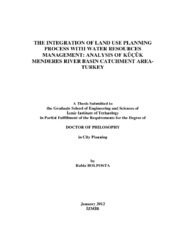Please use this identifier to cite or link to this item:
https://hdl.handle.net/11147/2908Full metadata record
| DC Field | Value | Language |
|---|---|---|
| dc.contributor.advisor | Özdemir, Semahat | en |
| dc.contributor.author | Bolposta, Rabia | - |
| dc.date.accessioned | 2014-07-22T13:48:35Z | - |
| dc.date.available | 2014-07-22T13:48:35Z | - |
| dc.date.issued | 2012 | en |
| dc.identifier.uri | http://hdl.handle.net/11147/2908 | - |
| dc.description | Thesis (Doctoral)--Izmir Institute of Technology, City and Regional Planning, Izmir, 2012 | en |
| dc.description | Includes bibliographical references (leaves: 313-333) | en |
| dc.description | Text in English; Abstract: Turkish and English | en |
| dc.description | xv, 348 leaves | en |
| dc.description | Full text release delayed at author's request until 2015.01.31 | en |
| dc.description.abstract | The role of water in land use planning has aroused a growing attention in the recent years. The importance of the linkage between water resources management and land use planning has been discussed in related literature, but there has been less attention to practical ways to implement and assess this concept in detail. As a result, an “Integrative Policy Framework (IPF)” first was set out by focusing on three national contexts -Netherlands, England and Australia, in terms of interpreting the phenomena of the contribution of land use planning to water resources management. This phenomena was then used to examine the legislative and institutional approaches in Turkish legal system in relation to planning and environmental management. From the analysis of this examination, it is argued that, the potential of land use planning system at present is not fully appreciated. There is a need to utterly identify and characterize the interactions between the water sector and the land use planning and to establish the process of making consistent joint for the water sector and the land-use concept. Finally, Institutional Analysis and Development (IAD) framework, developed around exogenous variables, action arena and five core dimensions based on Integrative Policy Framework, was applied to analyze the integration and the management activities in detail within Küçük Menderes River Basin catchment area. Results showed that this watershed faced institutional, administrative and financial problems. The research reinforces the importance of vertical and horizontal plan consistency, provincial and local leadership, building of networks among actors, emphasizing a process of problem assessment and strategy development on the local level to help the related watershed overcome problems. | en |
| dc.language.iso | en | en_US |
| dc.publisher | Izmir Institute of Technology | en |
| dc.rights | info:eu-repo/semantics/openAccess | en_US |
| dc.subject.lcsh | Water resources development--Turkey | en |
| dc.subject.lcsh | Water-supply--Turkey | en |
| dc.subject.lcsh | Land use--Turkey | en |
| dc.title | The integration of land use planning process with water resources management: Analysis of Küçük Menderes River Basin catchment area-Turkey | en_US |
| dc.type | Doctoral Thesis | en_US |
| dc.institutionauthor | Bolposta, Rabia | - |
| dc.department | Thesis (Doctoral)--İzmir Institute of Technology, City and Regional Planning | en_US |
| dc.relation.publicationcategory | Tez | en_US |
| item.openairecristype | http://purl.org/coar/resource_type/c_18cf | - |
| item.grantfulltext | open | - |
| item.cerifentitytype | Publications | - |
| item.fulltext | With Fulltext | - |
| item.openairetype | Doctoral Thesis | - |
| item.languageiso639-1 | en | - |
| Appears in Collections: | Phd Degree / Doktora | |
Files in This Item:
| File | Description | Size | Format | |
|---|---|---|---|---|
| 422699.pdf | DoctoralThesis | 9.27 MB | Adobe PDF |  View/Open |
CORE Recommender
Page view(s)
248
checked on Nov 25, 2024
Download(s)
332
checked on Nov 25, 2024
Google ScholarTM
Check
Items in GCRIS Repository are protected by copyright, with all rights reserved, unless otherwise indicated.